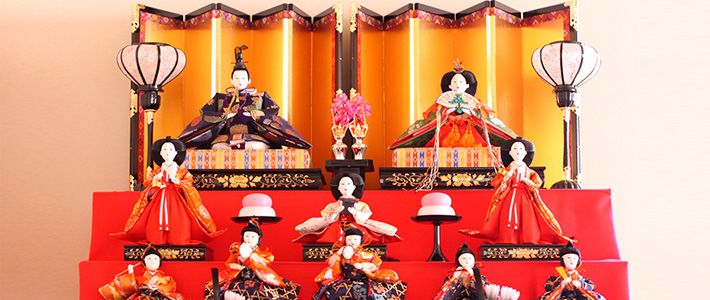
"Hinamatsuri": Japan’s Doll Festival
Culture- English
- 日本語
- 简体字
- 繁體字
- Français
- Español
- العربية
- Русский
An Early Spring Tradition
March 3 marks the observance of the hinamatsuri (doll festival), one of five sekku, or seasonal festivals, celebrated through the year. Together known as gosekku, these events took shape in part through the influence of Chinese philosophy and were first observed by courtiers during the Heian period (794–1185). They fell on the first day of the year’s first month, the third day of the third month, and so on—dates considered to be highly auspicious owing to the doubling of odd numbers for the month and date. (On the modern calendar, they are celebrated on January 1, March 3, May 5, July 7, and September 9.) On these days, ceremonies were conducted and special dishes prepared and eaten to ensure good fortune.
Over time, the March sekku took on aspects of a broader tradition involving the making of simple paper dolls called hitogata. These dolls were common toys for children of aristocratic families as well as serving as katashiro, or emblems used in purification rituals. The hinamatsuri gradually became a time to give thanks for the health and development of young girls, thanks to the influence of a traditional form of doll play called hina-asobi.
March 3 is also referred to as momo no sekku, or the peach festival. The blossoms of the peach tree, which according to the lunar calendar bloom around the beginning of the third month, are not only prized as harbingers of spring but are traditionally thought to ward off malevolent spirits. These aspects, along with their beauty, have combined to make them an essential decoration of the hinamatsuri.
Dolls in Full Courtly Attire
The most alluring aspect of the hinamatsuri is, of course, the intricately crafted dolls. These are displayed on a red-carpeted, stepped platform called a hinadan. On the top step are the central figurines of the festival, the male odairisama and female ohinasama. These figures, said to represent members of the imperial family, are waited on by the sannin kanjo (three court ladies), gonin bayashi (five musicians), and other attendants who sit, along with such court regalia as sake cups and elaborate chests of drawers, on lower steps. The dolls and regalia together are known as hinakazari. They can vary from simple affairs of only a couple steps to elaborate, multitiered displays. They originated in the court culture of Kyoto and first began spreading across the nation in the eighteenth century.
In the days leading up to the festival, households with young daughters display the ornately dressed figurines prominently, where they can be admired by family members and guests. However, once the festival is finished, custom dictates that dolls and decorations be quickly packed away, as it is believed that leaving them out too long will harm a daughter’s chances of marriage.
 The odairisama and ohinasama (in foreground) dolls.
The odairisama and ohinasama (in foreground) dolls.
Families often buy a new set of dolls when the first daughter is born, while others pass down hinakazari from one generation to the next. In the past it was not uncommon for new brides to take their set with them when they married. Undoubtedly, the hinadan represented one of the most splendid and valuable possession in the home and was cherished not just by girls, but the entire household. Many old hinakazari still remain and hold importance to broader society as cultural treasures.
Setting up, taking down, and storing the hinadan requires time, patience, and space. In recent years, simple, compact sets of dolls prearranged in glass cases have grown in popularity. Many families are also choosing to forego purchasing a full set in favor of one featuring only the odairisama and ohinasama, a type of display known as shinnō kazari.
The crafting of dolls is still a vibrant industry and one famous center of doll making is Iwatsuki in the city of Saitama, which boasts over 50 shops selling various types of figurines.
A Celebration of Femininity
In the days leading up to March 3 it is common for children to celebrate hinamatsuri by holding parties and enjoying such treats as hina-arare (multi-colored sweets made from rice and sugar), chirashi-zushi, clam soup, and red and white rice cakes called hishi-mochi. Traditionally, sprigs of peach blossoms are displayed along with dolls at these gatherings.
In certain regions the ancient tradition of the nagashi-hina is still observed. In this custom, which predates the hinamatsuri by centuries, spiritual impurities are transferred to paper dolls. The dolls are then discarded in a river and allowed to wash away in the current.
 An expansive hinadan in Katsuura, Chiba Prefecture.
An expansive hinadan in Katsuura, Chiba Prefecture.
In the past, a festival dedicated to the celebration of girls was a rare event among the broader culture dominated by men. However, as the country works to bring women to the forefront of society, the hinamatsuri has taken on new aspect as an event celebrating not just the young but all womankind.
Photo Captions:
Odairisama and ohinasama: Takashi M
Katsuura hinadan: Hamano Hideya